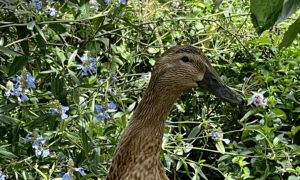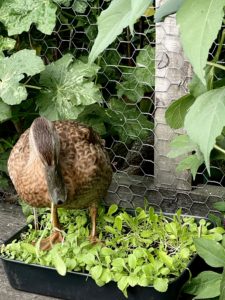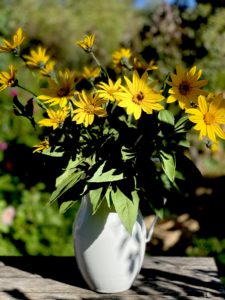
It’s 4am Sunday morning and I have been lying in bed for the last hour and a half thinking about the 2 metres (yes, 2 metres) of rainfall parts of Australia have had since January. The very same areas that are experiencing that amount of rainfall also experienced the devastating bush fires a couple of years ago. I cannot imagine how exhausted everyone is feeling who lives, works and owns businesses in those areas. Tending their land, their animals, their gardens. One thing after another with little government assistance.
I try to get some form of perspective, and put 2 metres of rainfall into some kind of context because it seems mind boggling, but all I can think of is damage control, loss of food crops and loss of seed production. Why seed production? Because a plant needs to fully mature and grow full circle to produce seed and ensure future crops. If crops are damaged by flood, they can’t reach maturity and produce seeds.
This effects us all, from the Australian backyard growers who rely on Australian seed companies to purchase their seed from, to the Australian seed companies who rely on Australian backyard growers and farmers who grow seed for them. This is merely scratching the surface.

My Instagram friend Ray who lives in the flood effected area shared a photo of his vegetable garden yesterday. It was empty. Empty. I admire Ray’s vegetable garden, the large harvests, but the ground is now too wet and waterlogged for anything to be growing in. At this time of year, Ray’s vegetable garden is always in full swing, harvesting the last of summer crops and well and truly established Winter crops are thriving. Here was a photo of an empty, bare vegetable garden.
Cressida from Pecora Dairy shared an Instagram Story yesterday, it was raining, again, the dam looking more like a lake and her sheep eagerly making their way inside to the dry dairy. Cressida explained that they will dry their sheep off early this year, it is a decision made by responding to the sheep not producing as much milk due to them using their energy to keep warm during this 2 metres of rainfall. Cressida and Michael have two Instagram accounts @pecoradairy and @pecoracheeseandwine
No doubt, no doubt, there are countless other stories of this flooding effecting backyard and commercial food growers, farmers and producers.
As a backyard food grower I’ve been lying awake asking myself questions, like what would I do if that amount of rain had been falling at Fairy Wren Cottage?
I think of damage control, growing what I can, composting, and for what it is worth I’ll offer my suggestions here. Maybe they will help in some way? Maybe they won’t. Keeping in mind every property is different, 2 metres of rain here in Southern Tasmania would come with different weather patterns compared to the warmer climate where the 2 metres of rain is actually falling. Maybe we would be experiencing the same conditions, who knows. Before I offer those suggestions can I just add here for context two things:
1. We have just experience the driest Summer in 40 years while this flooding has been happening elsewhere in Australia.
2. February, 19 years ago, I was a very pregnant woman waddling around the Northern Rivers. Lismore is a town in that area where we did our grocery shopping and where I went to the hospital and midwife appointments. It is one of the areas that is experiencing the worst ever flooding. At the time (19 years ago) it was recorded as the hottest summer in 100 years, being pregnant during such a weather event you remember it well. Michael and I had two sets of bags packed at the front door. A maternity bag for the hospital, and fire evacuation bags if we had to evacuate and leave in a hurry. It was so hot, the countryside was so dry. In 19 years the area where our daughter was born has gone from being the hottest to the wettest. It gets you thinking doesn’t it?

Freshly sown micro greens just starting to push through. Lettuce, beetroot & silverbeet.
Back to those ideas I had about the garden if we were experiencing the 2 metres of rainfall:
1. Damage Control: Try and preempt any branches being too weighed down, waterlogged and snapping. Prune branches to keep good airflow to prevent mould build up. Remove any fruit if it is still clinging on for dear life.
2. Take cuttings of any shrub or plant that looks like it is struggling. It’s a good time to take cuttings now anyway.
3. If the rosemary is getting too waterlogged take cuttings. Ironically, put 15cm long cuttings in a jar of water (strip the bottom half of the leaves off), until you start to see roots appearing, then plant into small pots full of potting mix. Tend to them over the colder months and make sure they get enough light. Plant out in Spring when the ground has warmed up.
4. Take any dry loving herbs out of the ground and pot them up in good quality organic potting mix. Keep them close to a window or inside in front of a window. They will appreciate the daylight, warmth inside or radiant heat from the window if outside. Think marjoram, oregano, lemon thyme and thyme.
4. Plant a couple of potato crops in large tubs or grow bags using good quality organic potting mix. Adam Jones has a great Youtube channel and tutorial for growing potatoes in pots plus he shares many other gardening tips! Adam’s Instagram page is @adamynyrardd
5. Start loading any clippings and branches into a big pile under a tree. The tree canopy will help keep the pile drier, the heap will help keep the tree roots drier. It will provide good habit for the wildlife, insects and bees.
6. Add as much mulch and manure as you can to the vegetable garden beds.
7. Let the chooks and ducks into the veggie garden if there is nothing growing in it. They will clear up any bugs and slugs. Added protein for their diet and a good distraction for them too. Do this in the afternoon when it is dry, like clock work they will want to make their way back to their enclosure when it is time for them to settle in for the night. The timing makes it as stress free as possible.

Looking much better in this photo than in real life, these micro greens were well & truely past their best productivity. Honeybee & the hens finished them. Potting mix went in the compost bin. Organic Potting Mix replaced and new micro lettuce seed sown. Nothing wasted.
8. What can you grow inside to keep those leafy greens appearing on your plate? Think micro greens in pots – we use 6cm deep baking trays filled with organic potting mix. How do you feel about sprouts? While alfalfa isn’t necessarily a favourite of mine, I do appreciate it rather than have nothing, and I tell myself it isn’t forever!
9. Are you able to accomodate more veg grown in pots undercover? Spring onions, coriander, kale, lettuce, broad beans – grow them to eat the tips and make pesto. I have a recipe for Broad Bean Pesto in my Instagram Highlights called Food.
10. Flowers for the soul. My sister mentioned recently that she loves to grow a pot of pansies next to her front door during Winter. They are cheery and bring her joy every time she walks past them. We grow pansies in a raised garden bed at our back door. Would a simple pot of pansies or potted colour you can buy at the garden centre (they cost about 3 for $10) be an option. It’s the little things that can help make a difference.
11. Indoor plants. I know it isn’t food but us gardeners need to tend plants. It’s a love thing.
Sometimes it isn’t about what you grow but actually the growing of something that gives hope. Tending, planting seeds and seedlings and plants is hopeful. And don’t we all need hope.
I’m thinking of you,
Jude x
PS. While we can’t afford to be sending large donations to everyone in need, (I would really like a magic wand that could help everyone), we are supporting small business who are experiencing hardship during the flooding. Would you consider that too?

Flooding & Food Growing.
April 3, 2022
comments
share